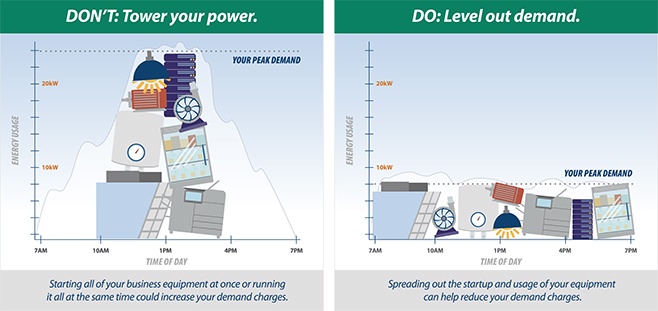This should only take a sec…

If you’re going to start a business or are currently running one, you may notice that your electricity bill looks a little different than your residential bill. That’s because business electricity bills are comprised of two usage-based components: an energy charge for the electricity you use over time (measured in kWh) and a demand charge based on the amount of electrical capacity (power) you need (measured in kW / kVA).
Demand charges come directly from your Transmission and Distribution Utility (TDU) and are based on the highest usage recorded over a 15-minute period within a given month. If your business tends to use a lot of power over short periods, your demand charges will comprise a larger part of your bill. If you use power at a more consistent rate throughout the month, your demand charges will generally be a smaller part of your bill. The way the TDU bills for demand charges is the same for all electricity providers, but some providers may not show the charges as separate line items on their bills.
Demand is how much electricity is needed at any moment, and demand charges are based on the maximum amount of electricity your business uses at any point in time, also known as your peak demand. It’s important for TDUs to know your peak demand because they must always be ready to supply that amount to you. Ultimately, TDUs want to be sure they can keep your business running.
Here's one way to think about demand.
Imagine that every business in your area receives water through a standard pipe, and that’s sufficient for most businesses in your area. But let’s say you have unique needs that sometimes require more water than is possible to deliver through the standard pipe. To meet these peaks in your water needs, the water company must install larger pipes to get more water to you. The added cost to install different sized pipes are covered by a "demand" charge.
Demand charges work the same for electricity. Here’s another example. Assume two businesses use the same amount of electricity each month. The first business uses a steady amount of electricity consistently throughout the month, but the second business uses more electricity at certain times of day or certain days of the month, using a lot of electricity at one time. It will cost the TDU more to meet the electricity needs of the second customer, so the second customer will have higher demand charges and higher electricity bills, even though both customers use the same total amount of electricity. Businesses like restaurants, churches and manufacturing companies tend to have higher electricity demand because they run a lot of equipment (A/C units, appliances, machinery) at once. Although churches may not use as much electricity in total, they are using all of it at the same time, with everything running for a few hours on Sunday.
